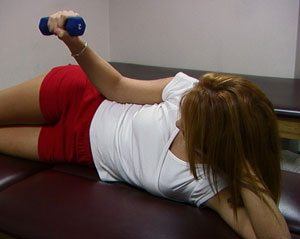Today’s guest post is written by Dennis Treubig, PT, DPT, CSCS. Dennis has some great thoughts and I couldn’t agree more with his motivation to push himself. This is a concept I talk about all the time. I love the first line below! Thanks for sharing, I think this information and the “progress” Dennis has made is a great example of thinking outside the box, while justifying your thoughts with scientific rationale. Good work Dennis, thanks!
Exercise Selection for Rehabilitation Programs

I think there are many physical therapists out there that bombard their patients with a slew of exercises thinking that more is better. These PT’s will add new exercises without taking out old ones, they will prescribe “3 sets of 10” for each exercise, and rarely progress the weight/resistance. These types of PT’s will also see a new, “cool” exercise somewhere and then, without proper discretion, try it with all of their patients. While this is not necessarily a “bad” treatment, I believe that we, as PT’s, should be better than this.
When I came out of PT school, I was eager to jump right in and try all these new & exciting manual techniques and exercises (for the purpose of this article I will obviously focus on the exercise aspect). While my patients were getting better, I found my treatment plans were loaded with exercises, making it difficult to know what was beneficial, which ones may have been causing soreness, and which ones weren’t even necessary. In addition, it was also making each patient’s treatment rather lengthy, which is not ideal when you practice in Long Island, NY where most of my patients are “limited on time.”
So, I went back to the research, followed some new professional blogs, and read books from different fields (physical therapy, strength & conditioning, business success, etc.) to see how I could better serve my patients. Here are some of the key points that resonated with me:
Selecting Reps and Sets
If the leading strength & conditioning specialists have their healthy clients doing only 3-5 main exercises (not including a little assistive work) when strength training, why would we put our injured patient through 7, 8, 9… exercises for “3 sets of 10?”
Since an injured patient is not going to be able to tolerate the volume of a healthy strength-training individual, we should be implementing volume less than that (and increasing it as necessary). And since when did 3 sets of 10 become the only way to exercise in a PT clinic. If strength & conditioning specialists constantly change the reps/sets to fit the needs of their client, why aren’t we? We should be altering the sets, repetitions, and resistance of the exercises to fit within that desired volume.
The Pareto Principle (80/20 rule)
In case you are not familiar with this principle, it states that, for most events, approximately 80% of the effects come from 20% of the causes. I believe this is applicable to rehab exercises – 80% of our results probably come from 20% of the exercises we give to patients (or should come from 20% of the exercises). This means that if you focus on the appropriate 3-4 exercises and cut out the rest, you will get similar results. And, I believe, better satisfaction from your patients.
Integrating Recent Research
Research articles that studied EMG analysis of therapeutic exercises have provided us with better information regarding muscle activity during each exercise.
Among others, articles by Reinold et al, Ekstrom et al, & Ayotte (references at end of article) have shed light on common exercises we prescribe. This allows us to re-evaluate the exercises we use and pick the ones that elicit the most desired muscle activity. And just because these articles looked at numerous exercises, it does not mean that we should pick every “good” exercise they looked at – be selective and choose the most worthwhile exercises.
The Jam Experiment

So, you’re probably asking, “How does this relate to rehab programs?” Here is where I first noticed this idea – anecdotally, when providing patients with a home exercise program, the more you give them, the less likely they are to perform it. Soon thereafter, I also became aware of it with regards to the exercise programs my patients went through. The more exercises they did, the less likely they were to remember how to do them correctly and the less intense they did them.
“Perfection is not when there is no more to add, but no more to take away.”
One day, I came across this quote from Antoine de Saint-Exupery and it definitely left an impression on me (personally and professionally). All too often, I see new, more complex exercises being added to patients’ programs without taking the basic exercise out. This becomes redundant, increases the volume, and lengthens the treatment time. For example, if your patient is doing wall squats, sit-to-stands, and leg press for 3 sets of 10, cut out the more basic sit-to-stands and wall squats and focus on the leg press. Do the leg press for 4-5 work sets and bump up the intensity. I bet you’ll get similar results with less work. This will free up time for important mobility/corrective exercises and more manual techniques. And by no means do I think that my treatment plans are perfect, but this quote makes you think about things in a different way.
After taking all this into account, I began to “trim the fat” and re-designed my rehab programs. I wanted my programs to be direct, efficient, easily understood, and reproducible (for after discharge). So, I started giving my patients 3-4 exercises, frequently altered the reps/sets/weights as necessary (usually in the 4-5 work set range and 4-8 rep range), educated my patients on the reasoning/technique/progression of the exercises and… TADA… the results were better than I had before.
Not only were the patients’ results better, but it also became easier for me to manage any problems that may arise. And when fewer exercises were implemented, my patients were retaining the information and able to make decisions on their own. Now, it’s not uncommon for me to tell my patient what exercise is next and after 5 minutes they’ll come up to me and tell me, “I warmed-up for 8 reps on 80 lbs, then did 2 sets of 8 at 100 lbs, 2 sets of 6 at 110 lbs and was only able to do 4 reps at 120 lbs.” When your patients are making decisions (and the right decisions) without your help, you know you have done your job right.
I hope this article makes you think about how you design your treatment programs and sparks some discussion in your clinic.
References
- Ayotte NW, Stetts DM, Keenan G, Greenway EH. Electromyographic Analysis of Selected Lower Extremity Muscles During 5 Unilateral Weight-Bearing Exercises. J Orthop Sports Phys, 2007;37:48-55.
- Ekstrom RA, Donatelli RA, Carp KC. Electromyographic Analysis of Core Trunk, Hip, & Thigh Muscles During 9 Rehabilitation Exercises. J Orthop Sports Phys, 2007;37:754-762.
- Ekstrom RA, Donatelli RA, Soderberg GL. Surface Electromyographic Analysis of Exercises for the Trapezius & Serratus Anterior Muscles. J Orthop Sports Phys, 2003;33:247-258.
- Ekstrom RA, Osborn RW, Hauer PL. Surface Electromyographic Analysis of the Low Back Muscles During Rehabilitation Exercises. J Orthop Sports Phys, 2008;38:736-745.
- Ferriss, Timothy. The 4-Hour Workweek: Escape the 9-5, Live Anywhere, and Join the New Rich. Crown Publishing Group, 2007.
- Iyengar SS, Lepper M. When Choice is Demotivating: Can One Desire Too Much of a Good Thing? Journal of Personality and Social Psychology, 2000;79:995-1006
- Reinold MM, Wilk KE, Fleisig GS, et al. Electromyographic Analysis of the Rotator Cuff & Deltoid Musculature During Common Shoulder External Rotation Exercises. J Orthop Sports Phys, 2004;34:385-394.
About the Author

[hr]




